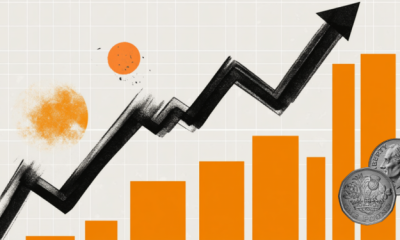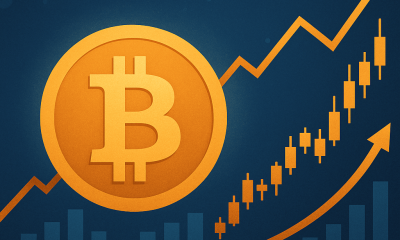

Blockchain
Blockchain can end the food fraud crisis, but it’s a costly battle – Crypto News
Food fraud siphons up to $50 billion from the global food industry every year and endangers public health. When deployed rigorously and realistically, blockchain could prevent this shadowy crime.
The problem? It comes with a high price tag. Scalability, cost, interoperability and integration pose significant barriers. Not to mention the privacy concerns, regulatory uncertainty and long path to stakeholder adoption.
But food fraud isn’t going anywhere. As David Carvalho, CEO of Naoris Protocol, observed:
“Most people would be surprised to hear that food fraud is an issue, but it’s a major one, costing the global food industry between $30 billion and $50 billion every year. That’s a small percentage of the sector’s total value — over $12 trillion — but still equivalent to the GDP of a small country like Malta.”
So, what’s to be done? And how can blockchain implementation truly be achieved?
Food fraud bites deeper than we realize
The Food and Agriculture Organization of the United Nations (FAO) outlines that food fraud involves purposefully deceiving customers about the quality or content of the food they buy.
Essentially, it’s the intentional substitution, addition or removal of materials for economic gain.
The typologies of fraud are diverse and sophisticated. These include mislabeling, theft, counterfeiting and dilution.
Real-world examples abound. Melamine has been added to milk in China to falsify protein content. Horsemeat has been sold as beef in Europe. Olive oil is often diluted with cheaper vegetable oils.
The economic toll is staggering. But the actual cost is far higher when accounting for reputational damage, regulatory compliance, legal battles and the erosion of consumer loyalty.
In some cases, the human cost can be far more devastating; the 2008 melamine scandal in China harmed over 300,000 infants.
Temujin Louie, CEO of Wanchain, highlighted the vicious cycle created by food fraud:
“An incident of fraud leads to a health scare, which erodes consumer trust. This diminished trust can translate into reduced sales for the implicated brand and the broader product category, thereby economically harming legitimate businesses.”
The damage is not calculated as the sum of individual losses. It should be calculated as a systemic weakening of the food industry’s foundation.
Cracks in the supply chain let food fraud fester
The complexity and opacity of global supply chains create fertile ground for fraud. The cold chain is particularly vulnerable.
Failures in cold chain logistics can lead to spoilage. These failures allow fraudsters to misrepresent storage conditions or sell compromised goods as fresh.
Fraud is not limited to high-profile cases or luxury goods. Dairy, spices, seafood, organic products, honey and fruit juices are frequent targets.
Carvalho added that fragmented data systems are a major Achilles’ heel:
“Many companies maintain their own internal tracking systems, but these often lack interoperability with their suppliers or customers. This results in ‘information islands’ preventing a holistic, end-to-end view of the supply chain.”
Fraudulent products enter and move through the system undetected without shared, reliable data.
Blockchain bites back
Blockchain technology can serve as an antidote to this growing crisis. Yet Louie cautioned that attempts in blockchain-based accountancy have had their share of challenges.
“In the 10+ years since Ethereum launched, we’ve yet to witness any true disruption,” Louie warned. “One reason why the promise of blockchains in supply chains has been largely unfulfilled is that early adopters were guilty of oversimplifying the problem.”
Blockchain technology’s core principles can create a more transparent and trustworthy system. Decentralization ensures that no single entity controls the data. And immutability guarantees that once data is recorded, it cannot be altered or deleted.
Related: A Bitcoiner’s guide to South Africa’s Garden Route
The benefits don’t end there. Selective transparency enables sharing relevant information with authorized stakeholders without exposing sensitive commercial data. Meanwhile, smart contracts can automate processes and enforce agreements.
Ultimately, cryptography ensures the integrity and security of the ledger. And to take it even further, integrating Internet-of-Things sensors with blockchain creates an immutable audit trail of environmental conditions, crucial for cold chain integrity.
Real-world implementations are beginning to bear fruit. In collaboration with IBM, Walmart uses Hyperledger Fabric to trace pork in China and mangos in the US, reducing trace times from days to seconds. TE-Food and Provenance offer blockchain-based traceability solutions that improve food safety and transparency. Major food companies like Nestlé and Carrefour and platforms like Seafood Souq are exploring blockchain to enhance supply chain transparency.
Louie emphasized the paradigm shift:
“Traditional food supply chains have operated on a model of trusting intermediaries, relying on paper documents, third-party certifications, and the word of various actors along the chain. Blockchain, in contrast, moves toward a system based on verifiable data.”
Carvalho explained the deterrent effect:
“A well-implemented blockchain system can act as a powerful deterrent, as the increased visibility and auditability make fraudulent activities riskier and more likely to be exposed.”
The decentralized deal
Despite its promise, blockchain is not a panacea. Scalability, cost, interoperability and integration with legacy systems pose significant barriers to adoption.
The “garbage in, garbage out” problem remains a fundamental limitation. Blockchain can only ensure the integrity of data once it is onchain — but it cannot be held responsible for the accuracy of the data entering the chain.
Oracles and IoT devices that feed external data onto the blockchain are vulnerable to tampering and technical failure. Manual data entry is also susceptible to error or manipulation. A perfect traceability record does not prevent a compromised oracle from feeding false data or a colluding party from entering fraudulent details at the point of origin.
Privacy concerns, regulatory uncertainty and stakeholder adoption are additional hurdles. Food supply chains involve sensitive data that businesses are reluctant to expose.
Related: AI agents are poised to be crypto’s next major vulnerability
Permissioned blockchains and selective transparency offer solutions. These do, however, require careful governance and clear data access protocols. Regulatory frameworks are evolving, and broad stakeholder participation is essential for success.
Louie advocates for a pragmatic approach. “Start with clearly defined use cases where blockchain can deliver demonstrable value, rather than attempting a broad, unfocused implementation,” Louie suggested. “Robust governance models, especially for consortium blockchains, are critical.”
Carvalho stressed the need for industry-wide standards, training and collaboration:
“Technology alone is insufficient. Success hinges on redesigning underlying business processes, investing in training and change management, and fostering a culture of collaboration and data sharing.”
A synthesized future for food integrity
The convergence of blockchain with IoT, AI and other innovations offers a promising path. IoT sensors provide real-time data on a product’s journey, creating a tamper-proof record.
AI algorithms analyze large data sets to detect anomalies and optimize logistics. Rapid testing methods, smart packaging, robotics and digital certificates further enhance food integrity.
The infrastructure built to fight fraud yields broader benefits. These include improved operational efficiency, reduced food waste and substantiated sustainability claims.
Blockchain and its complementary technologies have become attractive even for companies less directly affected by fraud. Pilot projects are yielding valuable lessons. Industry consortia are forming, and standards are beginning to emerge.
The potential rewards extend beyond reducing fraud to encompass improved food safety, reduced waste, enhanced consumer confidence and a more sustainable, equitable and resilient global food system.
The unseen bite of food fraud may be pervasive, but it is not invincible. If thoughtfully deployed and integrated, blockchain could be the trust layer that finally fixes the $50-billion food fraud problem.
Magazine: Crypto wanted to overthrow banks, now it’s becoming them in stablecoin fight
-

 Cryptocurrency1 week ago
Cryptocurrency1 week agoWhale Sells $407K TRUMP, Loses $1.37M in Exit – Crypto News
-

 Blockchain1 week ago
Blockchain1 week agoRobinhood Dealing With Fallout of Tokenized Equities Offering – Crypto News
-

 Cryptocurrency1 week ago
Cryptocurrency1 week agoSatoshi-Era Bitcoin Whale Moves Another $2.42 Billion, What’s Happening? – Crypto News
-

 Blockchain6 days ago
Blockchain6 days agoRipple and Ctrl Alt Team to Support Real Estate Tokenization – Crypto News
-
Technology6 days ago
Fed Rate Cut Odds Surge As Powell’s Future Hangs In The Balance – Crypto News
-

 Cryptocurrency1 week ago
Cryptocurrency1 week agoStrategy Resumes Bitcoin Buys, Boosting Holdings to Over $72 Billion in BTC – Crypto News
-

 Cryptocurrency1 week ago
Cryptocurrency1 week agoBitcoin Breaches $120K, Institutional FOMO Takes and House Debate Propel Gains – Crypto News
-
Technology6 days ago
Fed Rate Cut Odds Surge As Powell’s Future Hangs In The Balance – Crypto News
-
Business5 days ago
XLM Is More Bullish Than ETH, SOL, And XRP, Peter Brandt Declares – Crypto News
-
Cryptocurrency1 week ago
Why Is Bitcoin Up Today? – Crypto News
-
Business1 week ago
Pepe Coin Rich List June 2025: Who’s Holding Highest PEPE as it Nears Half a Million Holders? – Crypto News
-

 others6 days ago
others6 days agoEUR/USD recovers with trade talks and Fed independence in focus – Crypto News
-
Business5 days ago
XRP Lawsuit Update: Ripple Paid $125M in Cash, Settlement Hinges on Appeal – Crypto News
-

 Cryptocurrency5 days ago
Cryptocurrency5 days agoBitcoin trades near $119K after new all-time high; Coinbase rebrands wallet to ‘Base App’ – Crypto News
-

 Blockchain1 week ago
Blockchain1 week agoZiglu Faces $2.7M Shortfall as Crypto Fintech Enters Special Administration – Crypto News
-

 Cryptocurrency1 week ago
Cryptocurrency1 week agoCardano’s $1.22 target: Why traders should be aware of THIS ADA setup – Crypto News
-

 Metaverse7 days ago
Metaverse7 days agoWhy voice is emerging as India’s next frontier for AI interaction – Crypto News
-

 Metaverse6 days ago
Metaverse6 days agoNvidia’s Jensen Huang says AI ‘fundamental like electricity’, praises Chinese models as ‘catalyst for global progress’ – Crypto News
-

 others5 days ago
others5 days agoGBP/USD rallies on US PPI dip and Trump’s potential Powell removal – Crypto News
-

 others5 days ago
others5 days agoGBP/USD rallies on US PPI dip and Trump’s potential Powell removal – Crypto News
-

 Cryptocurrency1 week ago
Cryptocurrency1 week agoBitcoin and Ethereum ETFs record $3.6B inflows this week – Crypto News
-

 Technology1 week ago
Technology1 week agoAmazon Prime Day Sale 2025: Best earphones and headphone deals with up to 70% off – Crypto News
-

 Blockchain1 week ago
Blockchain1 week agoUK Banks Should not Issue Stablecoins – Crypto News
-

 Cryptocurrency1 week ago
Cryptocurrency1 week agoDonald Trump Jr. backs social media startup aiming to become a crypto powerhouse – Crypto News
-

 Technology1 week ago
Technology1 week agoGoogle, Anthropic, OpenAI and xAI join US defence to tackle national security with AI – Crypto News
-
Business1 week ago
CME XRP Futures Hit $1.6B In Total Trading Volume Since Launch – Crypto News
-
![Stellar [XLM] bulls exhausted after rally - Is a pullback nearby?](https://dripp.zone/news/wp-content/uploads/2025/07/Stellar-XLM-bulls-exhausted-after-rally-Is-a-pullback.webp-400x240.webp)
![Stellar [XLM] bulls exhausted after rally - Is a pullback nearby?](https://dripp.zone/news/wp-content/uploads/2025/07/Stellar-XLM-bulls-exhausted-after-rally-Is-a-pullback.webp-80x80.webp) Cryptocurrency1 week ago
Cryptocurrency1 week agoStellar [XLM] bulls exhausted after rally – Is a pullback nearby? – Crypto News
-
Cryptocurrency1 week ago
Fed’s Hammack Raises Inflation Concerns Amid Push For Interest Rate Cut – Crypto News
-

 Cryptocurrency7 days ago
Cryptocurrency7 days agoIt’s a Statement, Says Bitfinex Alpha – Crypto News
-

 Cryptocurrency6 days ago
Cryptocurrency6 days ago1inch price forecast: 1INCH hits 7-month high after double digit gains – Crypto News
-

 Cryptocurrency6 days ago
Cryptocurrency6 days ago1inch price forecast: 1INCH hits 7-month high after double digit gains – Crypto News
-
Business6 days ago
Ethereum Price Prediction- Bulls Target $3,700 As ETH Treasury Accumulation Soars – Crypto News
-

 others6 days ago
others6 days agoTop Crypto Exchange by Trading Volume Binance Announces Airdrop for New Ethereum (ETH) Ecosystem Altcoin – Crypto News
-

 De-fi5 days ago
De-fi5 days agoU.S. Marshals Peg Federal Bitcoin Holdings at 28,988 Tokens Worth $3.4 B – Crypto News
-
Cryptocurrency5 days ago
Russia’s $85 Billion Sberbank to Launch Crypto Custody Services – Crypto News
-

 Blockchain5 days ago
Blockchain5 days agoNasdaq Exchange Files SEC Form to List Staking Ethereum ETF – Crypto News
-

 Cryptocurrency4 days ago
Cryptocurrency4 days agoAnarchy, crime and stablecoins – Blockworks – Crypto News
-
Technology1 week ago
Peter Schiff Reignites Bitcoin Criticism, Calls 21M Supply Arbitrary – Crypto News
-
Business1 week ago
Ethereum ETFs Record Best Week Since Launch With $900M Inflows – Crypto News
-

 De-fi1 week ago
De-fi1 week agoOG Large-Cap Altcoins Lead Market Rally – Crypto News
-

 others1 week ago
others1 week agoJPMorgan Chase CEO Says Traders May Be Seriously Mistaken on Fed Rate Cuts: Report – Crypto News
-

 Cryptocurrency1 week ago
Cryptocurrency1 week agoFriday charts: The rise of zero-sum thinking – Crypto News
-

 others1 week ago
others1 week agoCrypto Hacker Who Drained $42,000,000 From GMX Goes White Hat, Returns Funds in Exchange for $5,000,000 Bounty – Crypto News
-

 Cryptocurrency1 week ago
Cryptocurrency1 week agoPump.fun Concludes $500M ICO in 12 Minutes — But Something Doesn’t Add Up – Crypto News
-

 Cryptocurrency1 week ago
Cryptocurrency1 week agoWhy Are So Many Crypto Games Shutting Down? Experts Weigh In – Crypto News
-

 De-fi1 week ago
De-fi1 week agoRobinhood Opens Ether and Solana Staking to US Users – Crypto News
-

 Cryptocurrency1 week ago
Cryptocurrency1 week agoTop 3 altcoins under $1 worth watching: Sei, Ethena, Arbitrum – Crypto News
-

 Blockchain1 week ago
Blockchain1 week agoThe Bitcoin Liquidity Supercycle Has Just Begun: Hedge Fund CEO – Crypto News
-

 De-fi1 week ago
De-fi1 week agoRipple’s RLUSD Market Cap Passes $515M, Flips TrueUSD – Crypto News
-
others1 week ago
Bitcoin Critic Vanguard Becomes Strategy’s (MSTR) Largest Shareholder – Crypto News


















